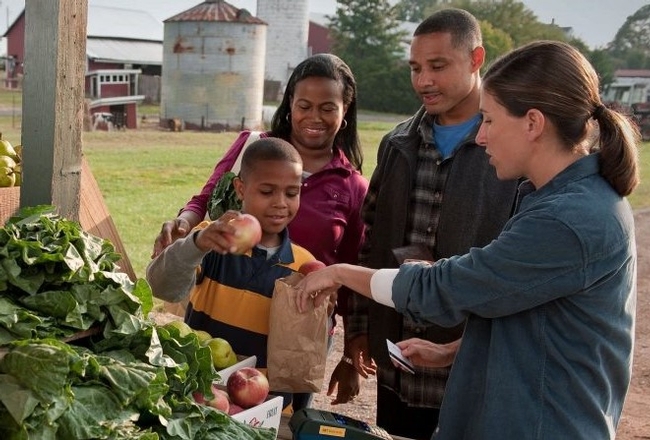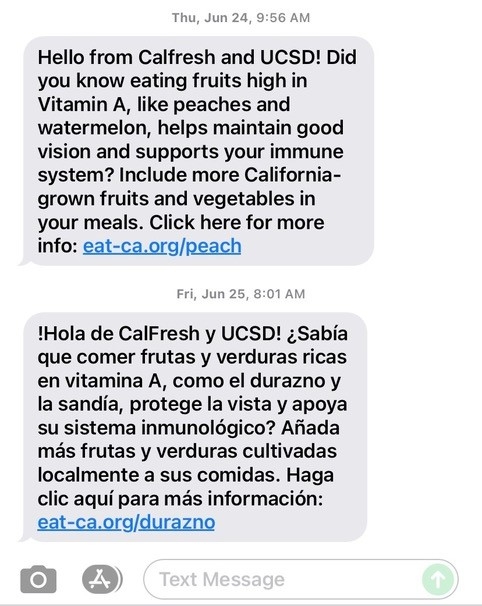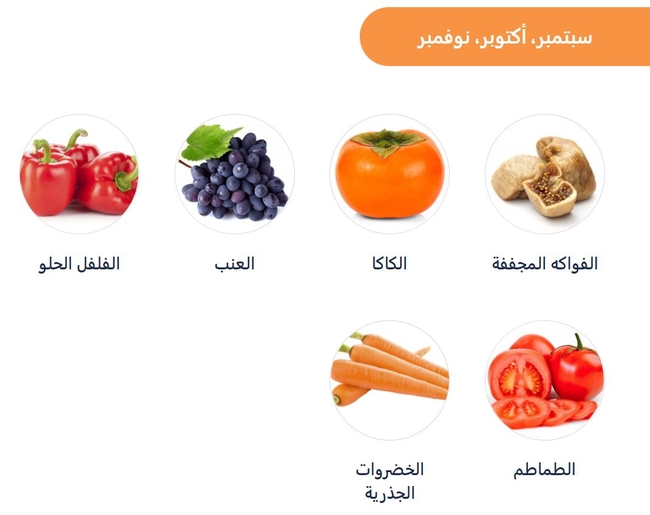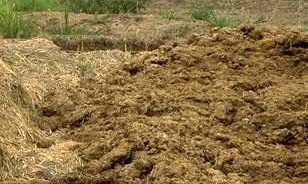Posts Tagged: Produce
CalFresh participants welcome texts on benefits of California-grown produce
The buzz or chirp of an incoming text message started some San Diego County residents on the path to a healthier diet during this past year. In September 2020, most CalFresh participants in the county – more than 172,000 households – began receiving monthly text messages about the benefits of California-grown fruits and vegetables as part of a pilot program.
This novel approach to delivering nutrition messages to California food assistance program participants was developed by a partnership of the Nutrition Policy Institute of UC Agriculture and Natural Resources, the UC San Diego Center for Community Health and the County of San Diego Health and Human Services Agency, which administers CalFresh in the county.
The HHSA, which had been using its text messaging platform to send administrative reminders and alerts, was receptive to using the tool for sending nutrition-focused information. NPI and CCH partnered with ideas42, a firm that applies behavioral science to solutions for social change, to develop a series of five text messages promoting California-grown fruits and vegetables.
The text messages – originally delivered in English and Spanish, with the addition of Arabic beginning in July 2021 – were friendly and conversational in tone.
“In a text, you have very few characters you're communicating with people, so we wanted to make sure we were using cutting-edge behavioral science to construct those messages to have the most impact,” said Wendi Gosliner, NPI senior researcher and policy advisor.
Each text included a link directing recipients to a website developed as part of the project, with information on selecting, storing and preparing California-grown fruits and vegetables; health benefits; tips to reduce food waste; and recipes – including TikTok videos.
Initially running from September 2020 to March 2021, the pilot program was well-received. Nearly 90% of CalFresh participants responding to a survey said they appreciated receiving the texts. “It is very important for us to eat healthy, to teach our children to eat healthy,” wrote one participant. “I love the recipes…they're so delicious and easy to make…I'm very, very grateful for the help because without you guys, I would be struggling more and I just want a better life for my children.”
Gosliner said it was encouraging to see that two-thirds of the approximately 5,000 survey respondents reported eating more California-grown fruits and vegetables after receiving the messages, and 85% expressed a desire to see more texts.
“What we see is that there's definitely a decent-sized population of people participating in CalFresh –now this is just in San Diego County but imagine the entire state – who would benefit from having this kind of information available to them,” Gosliner said. “And there is at least a subset of people who really liked it.”
UC San Diego's Center for Community Health was instrumental in facilitating the partnership between UC ANR and the HHSA. Further, CCH, in partnership with the San Diego County Childhood Obesity Initiative, formed a community council composed of residents representing diverse communities throughout San Diego County. Together, the council facilitated CalFresh participants to take part in focus groups, which provided feedback and guidance on the messaging and design for online resources. Gosliner said the success of the text program has been a direct result of community input and involvement.
“The Center for Community Health-led focus groups were integral to ensuring CalFresh resources were accessible and informative to a wide range of CalFresh participants, and local individuals and families more broadly,” said Blanca Meléndrez, executive director at the UC San Diego Center for Community and Population Health, Altman Clinical Translational Research Institute. “In the process, the text-based campaign also placed a greater focus on the local production of nutritious fruits and vegetables, ensuring access to healthy and nutritious food in all communities, and building new streams of income for the region's farmers and producers.”
This effort also suggests a simple way to reach CalFresh participants and bridge gaps between the Supplemental Nutrition Assistance Program and programming that offers nutrition education and healthy eating resources.
“By combining UCSD and UC ANR knowledge about healthy eating with our outreach capability, we are able to reach thousands of families via text message each month,” said Michael Schmidt, human services operations manager for the HHSA. “With the click of a button, these families are provided with resources to assist them in making healthier lifestyle choices, supporting a region that is building better health, living safely and thriving.”
The effort has been so effective that HHSA has asked for additional messages, beyond the original five months' worth of texts and resources.
“The partnership between UC ANR's Nutrition Policy Institute, UC San Diego's Center for Community Health, the County of San Diego Health and Human Services Agency and San Diego County community residents brought together a great team to develop an innovative, technology-based intervention,” said Shana Wright, San Diego County Childhood Obesity Initiative co-director at CCH. “Each partner provided knowledge, resources and assets that enhanced the project beyond the initial pilot phase, exceeding preliminary expectations.”
Gosliner said the pilot program has been a “great example and wonderful experience” of partnership in action.
“You can sit with your research or program ideas for a long time but if you don't have people who can help you implement them, then they really aren't helpful in any way,” she said. “In this case, it was just a nice combination of an idea…with partners who wanted to work to make something happen.”
Organic produce growers sought for research study
“The goal of our study is to provide organic farmers with science-based strategies that effectively limit food-safety risks when using raw manure-based soil amendments,” said Alda Pires, UC Cooperative Extension urban agriculture and food safety specialist in the School of Veterinary Medicine at UC Davis.
To study the survival of pathogens in soil and soil health, UC scientists are recruiting California growers who use raw or untreated manure in organically grown crop fields.
Pires is leading the project in California with Michele Jay-Russell, a veterinary research microbiologist and manager at the Western Center for Food Safety at UC Davis.
The researchers will visit participating farms eight times over the 2017-2018 growing season.
“We will collect produce, water, soil and manure samples,” said Jay-Russell. “All of the samples will be tested for bacterial indicators such as nonpathogenic E. coli and pathogens. We will ask the farmers to complete a short survey. The study is voluntary and all locations and names will be kept confidential.”
Eligible California farms must be certified as organic by the National Organic Program or California Certified Organic Farmers and fertilize with raw manure or untreated manure from dairy cattle, horses or poultry. The farms can grow any of the following produce: lettuce, spinach, carrots, radishes, tomatoes or cucumbers.
For more information or to enroll in the project, please contact Pires at (530) 754-9855 or apires@ucdavis.edu, or Jay-Russell at (530) 219-4628 or mjay@ucdavis.edu.
This study is being conducted in other states by the University of Minnesota, University of Maine, USDA Agricultural Research Service's Beltsville Agricultural Center, USDA Economic Research Service's Resource and Rural Economics Division, Cornell University and The Organic Center. The project is funded by a U.S. Department of Agriculture Organic Research and Extension Initiative grant.
Science-based food safety tips
Last month, I attended ScienceWriters2014, a joint meeting of the National Association of Science Writers, Inc, and the Council for the Advancement of Science Writing, in Columbus, Ohio. Held in cooperation with The Ohio State University, the conference attracted 430 freelancers, students, editors, staff journalists, public information officers and other lovers of science and science-writing. I had applied for a public information officer travel fellowship to attend it, and was fortunate to be awarded one by the NASW, greatly facilitating my attendance.
One of the events that attendees could sign up for was lunch with a scientist at The Ohio State University, located a few miles away from the conference venue. I chose Prof. Jeffrey LeJeune, an infectious disease microbiologist and epidemiologist, because a focus of his research is food safety, one of the topics included in the UC Global Food Initiative that UC President Janet Napolitano launched on July 1.
On the day of the luncheon, a Sunday, we were driven to The Ohio State University in buses the university provided. We assembled in the lobby of the Ohio Union (it was homecoming on campus and the Columbus marathon was in progress nearby), and were soon escorted to the tables of the scientists we had picked. The university kindly (and safely!) provided lunch.
At LeJeune's table, we introduced ourselves to one another. LeJeune began his presentation to his 15 guests by rebuffing the five-second rule. According to this rule, food dropped on the ground will not become contaminated with bacteria if it is picked up within five seconds of being dropped. LeJeune said it does not work. “Eating off the floor violates all food-borne illness prevention advice,” he warned.
Perhaps because we in his audience were all science writers, he proceeded to discuss communication challenges facing scientists. He said most of the emphasis in graduate training is on making discoveries, with hardly any attention paid to communicating these discoveries in lay language to benefit the general public. Other challenges he mentioned are the information explosion we are witnessing, resulting in deaf ears turned to many scientists' voices; and language barriers between scientists and journalists that hinder effective communication.
LeJeune then introduced the topic of raw milk. He said that while consuming raw milk is dangerous (CDC data for 1973-2005 shows that 56 percent of dairy-associated disease outbreaks result from raw milk/cheeses), less than one percent of milk consumed in the United States is raw.
“The pasteurization of milk was a huge benefit to the health of the human population,” he said. “Most cheeses in the U.S. are pasteurized cheese products.”
We asked him many questions. He answered them all. He explained that the U.S. has the safest food supply. Despite this, pathogens can enter the food chain through live animals, he cautioned. Further, refrigeration could be inadequate. He said about 80 percent of food and vegetable contamination occurs post-farm. His tip for what to eat when traveling: “Avoid raw or unpeeled foods. It is best to choose what is fully cooked and hot.”
LeJeune noted there is no evidence to suggest that GM foods are problematic from a food safety perspective.
“There are some concerns for sure,” he said. “But these are largely economic or political. Nutrition-wise, GM foods can be beneficial. From a food safety and nutritional standpoint, I also see no significant differences between organic produce and non-organic or regular produce. There could be, however, some environmental impacts related to the different production systems.”
More questions followed. A discussion on E. coli bacteria gathered momentum, specifically how E. coli gets infected with a virus and how, when this virus decides to leave E. coli, it releases Shiga toxins, which, in turn, damage cells lining the kidney.
We were so engrossed in the discussion that it came as a surprise when one of the organizers of the luncheon strode into the room to inform us that our hour with the scientist was up and that the bus that had transported us to The Ohio State University was about to leave.
As we rose hastily from our chairs we thanked LeJeune for his presentation, which was clear and to the point – qualities all science (and other) writers appreciate. We know he had other topics to discuss with us: Can I cook my Jack-o'-Lantern after Halloween? (The answer is “Not if it sits out for more than two hours.”) And are raw diets for dogs a public health concern for humans? (The answer is “Your dog is more likely to have Salmonella if it is eating raw food.)
Although we didn't get to these topics, he left us with ample useful information about food safety. On the ride back to the conference, the bus was loud with conversation from the various lunch groups – what had been learned, how best it could be communicated, and how each one of us had made a new friend at the university.
Small farmers find new marketing opportunities in San Francisco
Being a small-scale farmer has its advantages, including a certain cachet in today's modern marketplace, where high-end consumers are clamoring for fresh, locally grown foods, reported Stacy Finz in the San Francisco Chronicle.
The story focused on a tour last week organized by UC Cooperative Extension and the UC Agricultural Sustainability Institute intended to help small growers find new avenues to sell their products.
"Everyone wants to do business with them," said David Visher, a project analyst who helped organize the workshop. "We're not advocating that they choose processors over farmers' markets. We're just trying to show them their options and introduce them to the right people so they can make their own choices."
One of the growers on the tour, Emma Torbert, told the reporter she returned to her farm near Davis with a head full of possibilities.
Read more about the tour in the UC Food Blog post Cultivating connections between farmers and food buyers.
It's just a waste, II
A year ago, a co-worker wrote a post on this blog entitled “It’s just a waste.” The sad facts of food waste are something we pay attention to since we work for the UC Postharvest Technology Center. A key component of our Center’s mission is to “reduce postharvest losses.” This topic also hits close to home on a personal level since I have always struggled with using up produce before it spoils. I go shopping about once a week, and tend to purchase just a bit more produce than what we will actually eat – in the hopes that one of us will suddenly adopt healthier eating habits by increasing our intake of fresh produce. I place the produce in my fruit ripening bowl, on the counter, or in the fridge, according to the recommendations on my handy produce storage chart. But nearly every week something goes awry, usually with my schedule, and I end up not serving the delicious produce-based meals I had planned, or I forget to pack my lunch, and oops, the negative effects of delayed consumption hit my produce.
The numbers show I’m not alone in this struggle, since research reports that nearly 30 percent of all produce losses in the United States happen at the consumer level. I was surprised to learn that today the average American consumer wastes nearly 50 percent more food than we did in the 1970s. (Link to the August 2012 Natural Resources Defense Council Report.) In the Food & Agriculture Organization of the United Nation's chart you can see that consumers from every other region around the world do significantly better than we in using their produce.
I want to do better, too! I hereby resolve to try harder to stick with my menu plan, pay closer attention to produce on the counter and the fridge (sometimes known affectionately in the produce industry as the “black hole”), and I will try very hard to be more creative in my use or preservation of quickly ripening produce.
My single biggest challenge is bananas. I try to buy a smaller hand of 5 to 6 bananas with some green tint left. They go on my banana hook in a cooler corner of my kitchen. At least half the weeks of the year those bananas have black spots within 3 to 4 days, and by day 5 there are usually 2 to 3 bananas left that are no longer appealing to my family. So almost half the bananas I buy usually don’t get eaten. I know, I know, “buy a smaller hand of bananas,” you say. That’s easier said than done, at least at the markets in which I shop.
Thankfully there are many cooks out there willing to share their recipes for creative ways to use up an over-supply of bananas. Below is a starting list of ideas that I’ll be drawing from as I make an effort to reduce produce waste, and especially banana waste, in our home.
- Slice into 1-inch chunks, freeze in a single layer on a wax paper covered cookie sheet. Transfer into a zip-bag and return to the freezer to use as needed for fruit smoothies or other cooking projects
- Banana bread or banana muffins
- Homemade banana ice cream
- Banana layer cake with cream cheese frosting
- Slice lengthwise, sauté in butter and ¼ tsp. rum flavoring until golden brown, and serve on ice cream
- Banana crunch cookies
- Make banana pancakes, add chocolate chips if desired (here’s a link to a pancake recipe called “Chunky Monkey” my son-in-law likes to make)
- Peel, insert a lollipop or popsicle stick and freeze. Eat as is, or dip in melted chocolate.
- Banana drop cookies
- Slice, dip in fresh lemon juice, and dry in a dehydrator
- Make a warm spiced banana topping that’s great on ice cream or gingerbread
- Banana oatmeal bar cookies
- Banana pudding
- Fruit Skewers
- Bananas Foster
- Banana Daiquiri
- Tropical banana bar cookies with raisins, pecans and coconut
- Banana cream pie
- Peanut butter, banana and rum bar cookies
- Trifle
- Burrito Bananas Foster
- Fruit Salad
- Banana crepes
- Dessert Pizza
- Banana Bundt cake with caramel frosting
- Fruit salsa, served with cinnamon tortilla chips
- Banana split
- Strawberry-banana parfait with yogurt and granola











